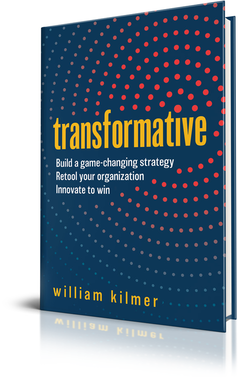Building a Challenge-Setting OrganizationGreat organizations learn how to stay in “Day 1” mode, continually evaluating and creating priorities that sustain their growth and performance. The OODA Loop serves as a model for organizations to observe, orient, decide, and act to improve their position at a high tempo. The challenge-setting organization creates a worldview, orientation, and first-principles way of thinking to create urgency and define its current priorities to succeed.
|
Excerpt from Transformative
|
In the introduction to this book, I stated that the greatest challenge organizations face is to develop the momentum to seek change, even when the need to change isn’t apparent. A fundamental component of that challenge is to seek change at a faster tempo than competitors. Clock speed—the pace and cadence of execution, and the ability to recognize the need for changes to implementation—is critical.
The answer to the call of innovating to win isn’t solely based on the next giant leap technological innovation. Many of the companies I’ve researched have taken advantage of significant advancements in enabling technology: Internet infrastructure, software, data analytics, cloud computing architectures, and mobile devices, for example. Some, like Intel and Salesforce, are technical pioneers in hardware, software, and cloud infrastructure. But their real breakthrough came from uncovering unknown needs and envisioning and creating better outcomes, sometimes before the customers themselves understood them. Because of that, change is founded less on encountering and adapting to the next set of challenges and more on setting up your organization to look for new opportunities deeply and frequently. The essence of the transformative framework outlined in this book is that organizations can use a set of principles and accompanying questions to find and create opportunities for themselves by innovating at multiple levels: solution outcome, market and industry structure, and organization. It’s an acknowledgment that innovation is more than just a game of chance or waiting for that next strategic inflection point. True game-changing innovation is broader and starts with a vision to create something unique and valuable. Your ability to reach your objective as an organization depends less on getting the answers to these questions perfectly right the first time than it does on your persistence in trying to answer them and your resilience in overcoming mistakes to find the right path forward. Transformative leaders encourage and sustain a pattern of becoming a challenge-setting organization—one that moves forward quickly by continually defining a set of challenges to accomplish. For Jeff Bezos, this is the essence of always staying in “Day 1” mode. Day 1 is a reference to Bezos’s first letter to shareholders in 1997 when the Internet was new, and Amazon, with $15 million in revenue the year before, had determined how it would use the Internet “to create real value for its customers and, by doing so, hopes to create an enduring franchise, even in established and large markets.” In Day 1, Amazon understood the landscape in front of them, created a massively intentional goal, and started to build what they saw was needed to achieve it. |
Explore this and other topics in the upcoming book Transformative.
|
